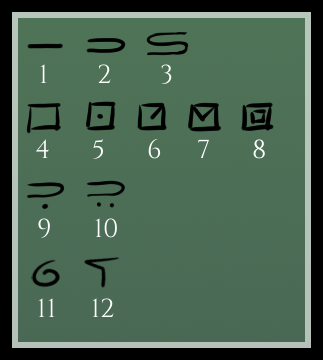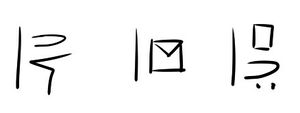Difference between revisions of "Mandae numeral system"
| (9 intermediate revisions by the same user not shown) | |||
| Line 1: | Line 1: | ||
| − | '''Mandae numeral system''' is a dozenal numeral system used on the [[Continent]]. It was developed some time during the [[dantrian_calendar|first revolution]] and has gradually replaced base 6 and decimal numeral systems used throughout | + | '''Mandae numeral system''' is a dozenal numeral system used on the [[Continent]]. It was developed some time during the [[dantrian_calendar|first revolution]] and has gradually replaced base 6 and decimal numeral systems used throughout the Continent. It is a positional system. It did not have a zero at the beginning, but eventually adopted it. |
| − | Just like the [[Mandae]] language, during the | + | Just like the [[Mandae]] language, during the first revolution the Mandae numeral system became an elitarian numeral system, existing alongside the Dantrian numerla system, which was decimal. The latter wasn't even positional and was used by the common people for basic calculations. A specialized positional decimal system was used by architects and other professionals in Central and Western Dantria. |
| − | Mandae numeral system quickly found its way to the east through diplomatic channels. It took hold in [[Yammoe]], which at that time already had a system of public education, and recognized a base 12 numeral system as a better tool to teach arithmetic. By the | + | Mandae numeral system quickly found its way to the east through diplomatic channels. It took hold in [[Yammoe]], which at that time already had a system of public education, and recognized a base 12 numeral system as a better tool to teach arithmetic. By the beginning of the second revolution its use spread to Gantolia and was later adopted by Asdoh. |
| − | [[Land]] and [[Zamborana Zambonia]] (later [[Zambon]]) continued to use a positional decimal system of the sort used by experts in Western and Central Dantria up until the | + | [[Land]] and [[Zamborana Zambonia]] (later [[Zambon]]) continued to use a positional decimal system of the sort used by experts in Western and Central Dantria up until the middle of the second revolution. |
| − | The [[Dantrian calendar]] uses a decimal system, as the widespread adoption of the Mandae numeral system for calculation came | + | The [[Dantrian calendar]] uses a decimal system, as the widespread adoption of the Mandae numeral system for calculation came after the adoption of the calendar. Therefore, today the inhabitants of the [[Continent]] treat years as obeying a very special, somewhat alien numeric system, different from the usual dozenal arithmetic they use in everyday life. At the same time, the name of the ordinals, as well as the symbols, are in Mandae even for the decimal system of the Dantrian calendar. |
Mathematical research is done in the Mandae system. | Mathematical research is done in the Mandae system. | ||
| + | |||
| + | == Basic notation == | ||
| + | |||
| + | [[File:Mandae numbers.png|left]] | ||
| + | |||
| + | Mandae has twelve digits, from 1 to 12. They are traditionally broken down into four groups: somes, sundial, olds and bigs. Somes are 1, 2 and 3 and "somes" means "a little bit", "numbers that indicate just some". The sundial group refers to the way the symbols incrementally add elements in order to indicate growth: a 4 is a square, a five adds a dot to the square, the 6 adds a line, the 7 adds two and, finally, an 8 is a square within a square, which is a way of displaying two 4s. The olds are united by a similar incremental symbol, which takes the basic element of 2 and adds a dot and then two dots. Finally, the bigs are simply the two largest digits, 11 and 12. | ||
| + | |||
| + | It is not uncommon to see the square smoothed out into a circle in writing. This is especially prevalent in [[Tarnaria]], since the [[bukk|bukkean]] alphabet is largely based on circles. | ||
| + | |||
| + | The general incremental nature of the symbols can actually be observed in digits 1 through 8: 1 is a line, 2 is essentially two connected lines, 3 is three and four is a square, made up of 4 lines. Then elements are incrementally added up to 8. | ||
| + | |||
| + | While there are special symbols for 72, 144 and 1728, numbers up to 144 can be pretty comfortably written down using the available twelve digits. One uses a vertical line called "staff" (a literal translation from Mandae) to sum the digits, thus producing a new digit. For instance, if one wishes to write down 14, one can write it as any combination of the two digits, be it 12+2 or 11+3 or 10+4. Different countries tend to adapt several common combinations, and the rule of thumb is two try to use the 12. So, in case of 14 it would be more common to represent it by doing 12+2. Typically, the smaller number is on top and the larger number is at the bottom. One can also simply put one number after the staff, which would mean that the number is summed by itself, thereby allowing to write down 14 as 7+7: | ||
| + | |||
| + | [[File:Compound numbers.jpg|center|thumb|The number 14 represented in three different ways: 2+12, 7+7 and 4+10.]] | ||
| + | |||
| + | Note that these are not sums per se, but instead representations of numbers. For instance, 2+12 in the picture above is treated as number 14 that can then be used in mathematical operations. | ||
| + | |||
| + | == Cultural influence == | ||
| + | |||
| + | The influence of the Mandae numeral system is ubiquitous. The Sacred Game of Roads of [[Xaewoon]] takes its influence from somes - 1, 2, 3 - treating them as an incremental path. It also explains why the number 5 is treated as sacred by the Xaewoon believers, since this is the amount of times the road in the Sacred Game of Roads turns, continuing the logic of the Mandae symbols by adding two more turns. | ||
| + | |||
| + | [[Rahkahnja]] treats the Mandae numeral system visually, with temples adopting the layout that matches one of the 12 digits. | ||
| + | |||
| + | The significance of the dozenal numeral system is also reflected in the fact that across most cultures on the Continent 12 is considered to be the age of ascension. | ||
Latest revision as of 00:29, 5 January 2021
Mandae numeral system is a dozenal numeral system used on the Continent. It was developed some time during the first revolution and has gradually replaced base 6 and decimal numeral systems used throughout the Continent. It is a positional system. It did not have a zero at the beginning, but eventually adopted it.
Just like the Mandae language, during the first revolution the Mandae numeral system became an elitarian numeral system, existing alongside the Dantrian numerla system, which was decimal. The latter wasn't even positional and was used by the common people for basic calculations. A specialized positional decimal system was used by architects and other professionals in Central and Western Dantria.
Mandae numeral system quickly found its way to the east through diplomatic channels. It took hold in Yammoe, which at that time already had a system of public education, and recognized a base 12 numeral system as a better tool to teach arithmetic. By the beginning of the second revolution its use spread to Gantolia and was later adopted by Asdoh.
Land and Zamborana Zambonia (later Zambon) continued to use a positional decimal system of the sort used by experts in Western and Central Dantria up until the middle of the second revolution.
The Dantrian calendar uses a decimal system, as the widespread adoption of the Mandae numeral system for calculation came after the adoption of the calendar. Therefore, today the inhabitants of the Continent treat years as obeying a very special, somewhat alien numeric system, different from the usual dozenal arithmetic they use in everyday life. At the same time, the name of the ordinals, as well as the symbols, are in Mandae even for the decimal system of the Dantrian calendar.
Mathematical research is done in the Mandae system.
Basic notation
Mandae has twelve digits, from 1 to 12. They are traditionally broken down into four groups: somes, sundial, olds and bigs. Somes are 1, 2 and 3 and "somes" means "a little bit", "numbers that indicate just some". The sundial group refers to the way the symbols incrementally add elements in order to indicate growth: a 4 is a square, a five adds a dot to the square, the 6 adds a line, the 7 adds two and, finally, an 8 is a square within a square, which is a way of displaying two 4s. The olds are united by a similar incremental symbol, which takes the basic element of 2 and adds a dot and then two dots. Finally, the bigs are simply the two largest digits, 11 and 12.
It is not uncommon to see the square smoothed out into a circle in writing. This is especially prevalent in Tarnaria, since the bukkean alphabet is largely based on circles.
The general incremental nature of the symbols can actually be observed in digits 1 through 8: 1 is a line, 2 is essentially two connected lines, 3 is three and four is a square, made up of 4 lines. Then elements are incrementally added up to 8.
While there are special symbols for 72, 144 and 1728, numbers up to 144 can be pretty comfortably written down using the available twelve digits. One uses a vertical line called "staff" (a literal translation from Mandae) to sum the digits, thus producing a new digit. For instance, if one wishes to write down 14, one can write it as any combination of the two digits, be it 12+2 or 11+3 or 10+4. Different countries tend to adapt several common combinations, and the rule of thumb is two try to use the 12. So, in case of 14 it would be more common to represent it by doing 12+2. Typically, the smaller number is on top and the larger number is at the bottom. One can also simply put one number after the staff, which would mean that the number is summed by itself, thereby allowing to write down 14 as 7+7:
Note that these are not sums per se, but instead representations of numbers. For instance, 2+12 in the picture above is treated as number 14 that can then be used in mathematical operations.
Cultural influence
The influence of the Mandae numeral system is ubiquitous. The Sacred Game of Roads of Xaewoon takes its influence from somes - 1, 2, 3 - treating them as an incremental path. It also explains why the number 5 is treated as sacred by the Xaewoon believers, since this is the amount of times the road in the Sacred Game of Roads turns, continuing the logic of the Mandae symbols by adding two more turns.
Rahkahnja treats the Mandae numeral system visually, with temples adopting the layout that matches one of the 12 digits.
The significance of the dozenal numeral system is also reflected in the fact that across most cultures on the Continent 12 is considered to be the age of ascension.

